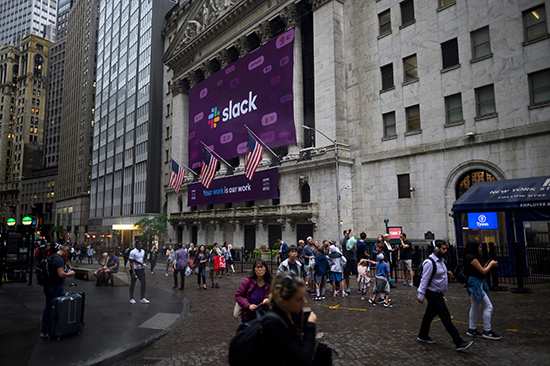科技独角兽已经死了?太夸张了

|
对科技行业里某些曾经被夸上天的独角兽来说,今年一直纷乱不安。 在上市新股走势欠佳(像Lyft和Uber)以及IPO表现糟糕之际(比如WeWork),判断2019年会不会出现泡沫破裂算不上什么难事,而这个泡沫就出现在科技公司的身上,它曾经把投资者旺盛的胃口变成了极为膨胀而且不受控制的私募估值。 但在高盛的科技投行业务主管看来,对打算涉足资本市场的科技公司来说,负面新闻掩盖了依然良好的环境。 高盛的全球科技、传媒和电信(TMT)集团负责人尼克·乔瓦尼对《财富》杂志表示:“有几家非上市公司这几年过的很难,但独角兽就要死亡的报道有些言过其实。” 乔瓦尼指出,美国的科技公司上市规模已经连续四年上升,而且他预计这样的势头将延续到2020年。他说:“这两年我们一直在说出现了‘超大周期’,现在我们正处于其中。我觉得2020年将成为科技公司IPO市场连续扩张的第五个年头。” 去年的一大特点是私募估值数百亿美元的科技宠儿发现股市中的日子可能并不好应付,这里还会强调透明度和对股东的责任。但乔瓦尼说这种“成长的烦恼”对较年轻的公司来说并不是什么新鲜事,而且不断扩大的未上市初创公司群体仍然会设法上市。 他说:“确实有一些知名公司上市后的表现并不好,还有些高调的[未上市公司]价值缩水,但这并非新的现象。在这个阶段,股市必须学习怎样对私募[估值]基准较高的公司进行估值和交易,学习怎样交易直接上市的股票。我们对这些趋势持有乐观态度。” 公司上市新途径 说到直接上市,乔瓦尼认为资本市场已经发现了在他看来可以延续的“创新”。高盛为今年夏天直接上市的Slack提供了顾问服务,这家协同办公软件公司跟随着Spotify(2018年直接上市)的脚步,选择了一条到目前为止仍不寻常的路径。 直接上市模式允许公司将投资者持有的已发行股份拿到公开交易所中,而不是像IPO那样为自身股票的交易而发行新股。直接上市的公司绕开了承销商等中介机构,也避免了已有股份被稀释。 当然,直接上市模式也有局限性,比如无法通过发行新股来筹集资金。乔瓦尼说这已经让“需要融资”的拟上市公司望而却步。但这种情况有可能就要发生改变,因为11月26日有报道称纽约证券交易所已经向联邦监管部门提交申请,打算允许公司通过直接上市融资。 乔瓦尼补充说,无论此举能否避开高额承销费,或者能否让投资者得以套现,和以前相比,“考虑直接上市的公司都要多得多”,而且2020年通过这种途径上市的公司数量也会有显著增长。 他认为,直接上市模式出现后还有可能成为一个跳板,从而“让今后的公司找到新的上市方法”,而且投资银行、监管部门和交易商一直在探讨让公司获得资金的潜在新途径。 并非只有消费科技 虽然Pinterest和Peloton等面向消费者的公司吸引了股市的很大一部分注意力,但恢复活力的企业软件行业在2019年同样名声大噪,CloudStrike、Cloudflare、Dynatrace和Zoom等公司都通过IPO获得了资金。 乔瓦尼说:“我们发现,达到较大规模的企业软件公司数量有了迅猛增长”,这源于“企业软件在开发和销售方面的创新”。他还指出,随着企业技术需求的演变以及公司为其安装的软件投入更多资源,“我们预计这个趋势将延续下去”。 私募资金依然强势 与此同时,虽有人担心过多的泡沫不利于实际投资环境,但私募市场仍然在向前迈进。 高盛的研究显示,美国风险投资人通过彻底退出获得的回报在2019年首次突破2000亿美元。此外,他们的“弹药”也比以往任何时候都充足。高盛引用企业统计机构PitchBook的数据称,美国和欧洲风投公司尚未使用的资金达到了创纪录的1440亿美元。 当然,高盛的研究还发现,今年风投的融资步伐明显放慢,2019年关闭的基金数量及其筹集的资金规模都低于近期的历史高点。由于软银还没有完全摆脱WeWork崩盘的不利影响,也有人高度怀疑私募价值能否准确地体现公司的发展前景。 乔瓦尼承认:“公司的重点是不计代价地扩张以及谋划未来的融资能力,从这个角度讲,投资者和公司都有所退出。” 但由于许多私募投资者仍然通过漂亮地退出而获得了高额收益,他相信私募市场“仍在非常顺利地运转”。 乔瓦尼说:“支持顶尖公司的资金非常多,可以帮它们起步并扩大规模。我们在过去一年中看到私募创造出了巨大的价值。”(财富中文网) 译者:Charlie 审校:夏林 |
It’s been a tumultuous year for some of the tech sector’s once vaunted unicorns. With underwhelming public market debuts (see: Lyft and Uber) and botched IPOs (a la WeWork), it’s hardly a stretch to wonder whether 2019 saw the bursting of a bubble—one characterized by tech firms that had parlayed robust investor appetite into grossly inflated, runaway private valuations. But according to Goldman Sachs’ top tech investment banker, negative headlines have overshadowed what continues to be a strong environment for tech firms looking to tap the capital markets. “A handful of private companies had difficult years, but the reports of dying unicorns are greatly exaggerated,” Nick Giovanni, head of the global technology, media, and telecom (TMT) group at Goldman Sachs, told Fortune. Giovanni cited what’s been a fourth consecutive year of growth in U.S.-listed IPO volume by tech companies—a dynamic that he expects to continue going into 2020. “We’re in the middle of what we’ve been talking about for two years as a ‘megacycle,’” he noted. “I’d expect 2020 to be the fifth year in a row of growth in the tech IPO market.” This past year was marked by tech darlings with private valuations in the tens of billions of dollars finding that life on the public markets—complete with heightened transparency and accountability to shareholders—can be a tricky proposition. But Giovanni says such growing pains are nothing new for relatively young companies, and pointed to an ever-larger backlog of private startups that will still look to go public. “There were certainly some high-profile companies that went public and did not trade well, and some high-profile [private] write-downs, but that’s not a new phenomenon,” he says. “This is a period where the public markets are having to learn how to value and trade companies with private [valuation] benchmarks that are higher, and learn how to trade direct listings. We’re optimistic about these trends.” New ways for companies to go public With direct listings, Giovanni thinks the capital markets have found an “innovation” that he believes is here to stay. Goldman Sachs advised Slack on its direct listing this past summer, with the workplace software firm following Spotify (which went public via direct listing in 2018) in pursuing a heretofore unconventional route. The direct listing model allows companies to list existing shares held by investors on a public exchange—rather than offering new shares for trading, as is done in an IPO. It allows them to bypass intermediaries such as underwriters, and also avoids the dilution of the company’s existing stock. Of course, there are limitations to the direct listing model—such as an inability to raise money via offering new shares—which have dissuaded companies “that need to raise capital” in their public forays, Giovanni said. But that could be set to change, with November 26’s news that the New York Stock Exchange has filed paperwork with federal regulators seeking to allow companies to raise fresh capital via direct listings. Whether it’s avoiding hefty underwriting fees or granting investors the ability to cash out shares, Giovanni added that “many more companies are considering direct listings” than before, and will pursue them as an avenue to going public in 2020. The emergence of the direct listing model could also prove a jumping off point to “find[ing] new ways for companies to go public” in the future, he noted—with investment banks, regulators and exchanges continuing to discuss new potential paths for companies to access capital. Not just consumer tech While consumer-facing companies like Pinterest and Peloton grabbed much of the attention on the public markets, a resurgent enterprise software sector had a banner year in 2019—with the likes of CloudStrike, Cloudflare, Dynatrace, and Zoom all capitalizing via IPOs of their own. “We have seen a tremendous growth in the number of enterprise software companies achieving larger scale,” Giovanni said, attributing that growth to “innovations in the way that enterprise software is developed and distributed.” With businesses’ technological demands evolving and companies pouring more resources into the software they deploy, “we see that trend continuing,” he added. Private funding still strong The private financing markets, meanwhile, continue to roll on despite concerns that the investment environment has proven too frothy for its own good. U.S. venture capital investors saw their bets rewarded with more than $200 billion in total exits for the first time in 2019, according to Goldman Sachs research. What’s more, there’s more dry powder out there than ever; U.S. and European VCs are holding a record $144 billion in uninvested capital, according to PitchBook data cited by Goldman. Of course, the bank’s research also notes that VC fundraising slowed down notably this year, with fewer funds closed and less money raised in 2019 compared to recent record levels. And with SoftBank still wiping the egg off its face from the WeWork debacle, there’s heightened skepticism about whether private valuations are an accurate barometer of a company’s prospects. Giovanni acknowledges that “to the extent that companies were focused on scaling at all costs and planning on the ability to raise money in the future, you’ve seen investors and companies pull back a small amount.” But with many private investors continuing to generate strong returns thanks to robust exits, he believes the private markets “are still functioning very well.” “There is a lot of capital to support great companies, to help them start and scale,” he says. “We’ve seen a significant amount of private value creation over the course of the last year.” |













